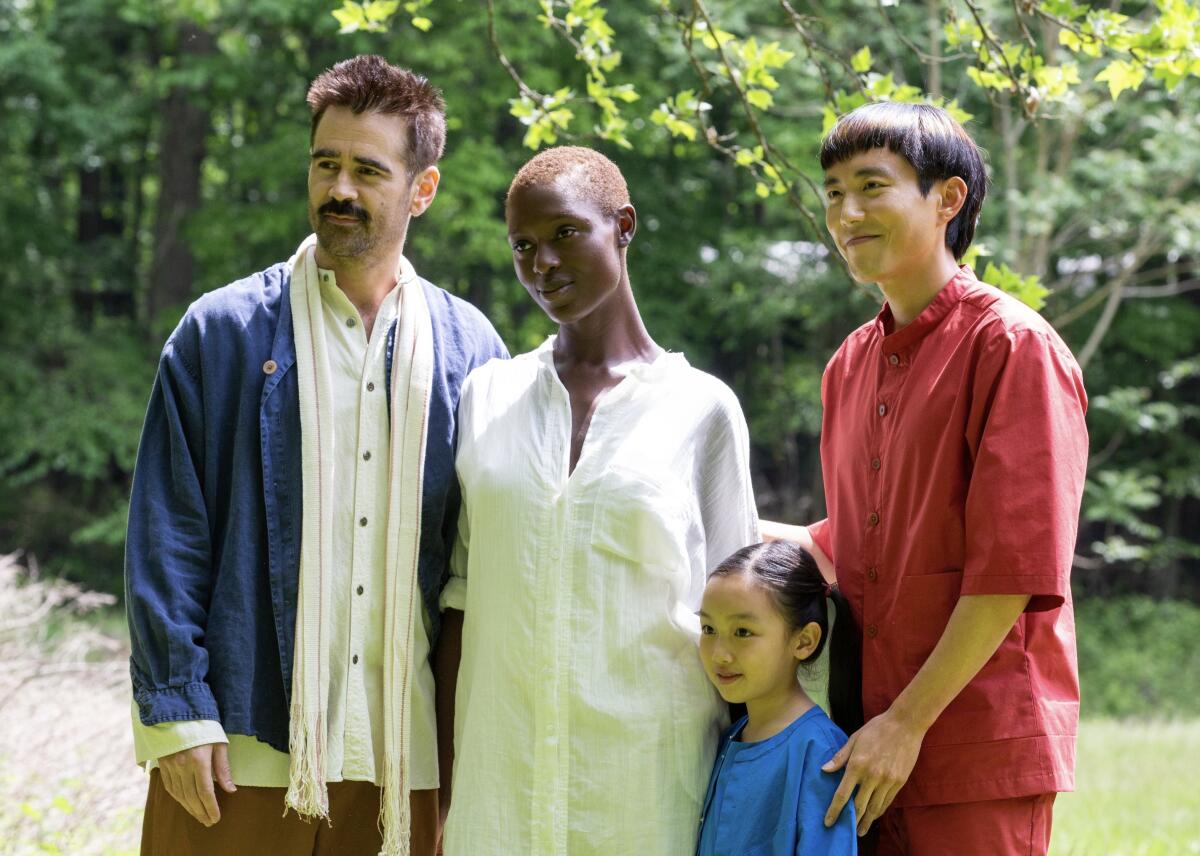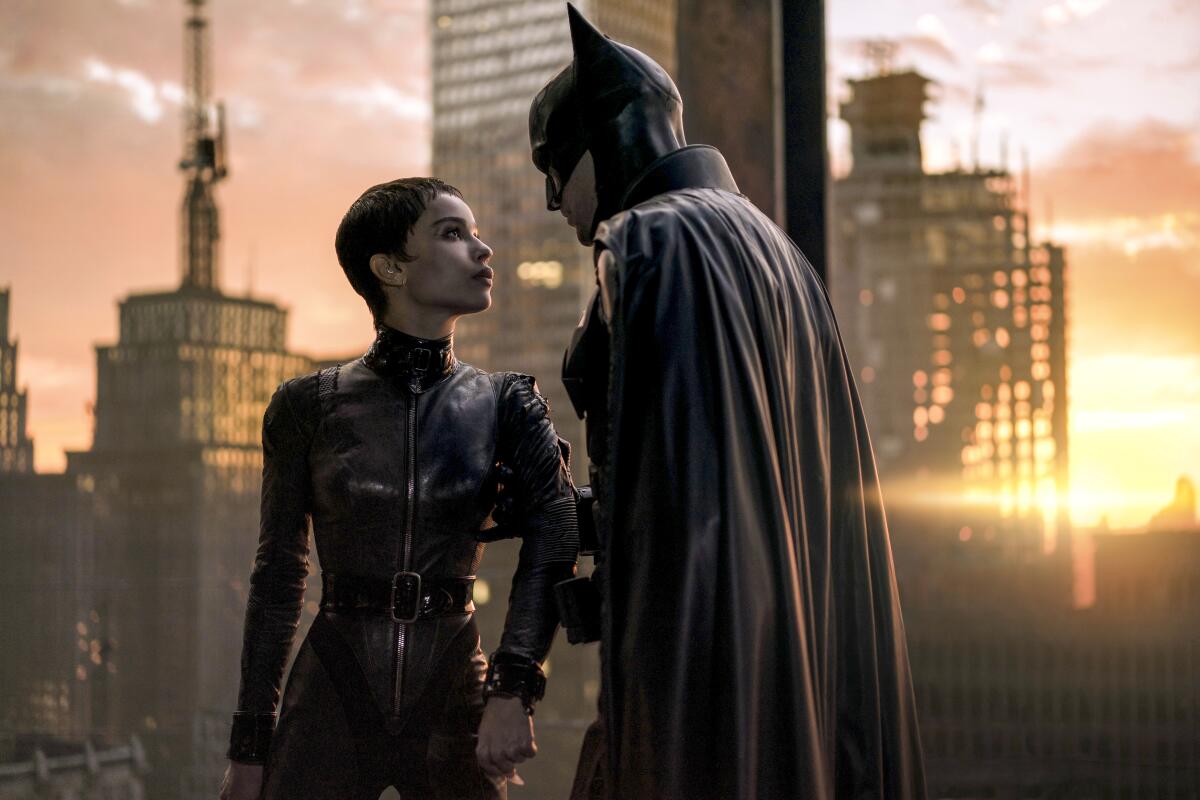A double dose of Colin Farrell with ‘After Yang’ and ‘The Batman’
Hello! I’m Mark Olsen. Welcome to another edition of your regular field guide to a world of Only Good Movies.
Only good movies
Get the Indie Focus newsletter, Mark Olsen's weekly guide to the world of cinema.
You may occasionally receive promotional content from the Los Angeles Times.
Sheila Benson, who was the chief film critic at The Times from 1981 to 1991, died recently at the age of 91. Her time as a critic coincided with the rise of the studio blockbuster and the emergence of the American independent film movement, and Benson could be enthralled by both.
“No matter what Sheila wrote, whether it was a positive, lukewarm or negative review of a film, you could always sense that she had a tremendous love and affection not only for the art of making movies but also for the people who made them,” said Barbara Saltzman, who was Daily Calendar editor when Benson was film critic. “She firmly believed that no writer or director or actor set out to make a bad film.”
Jen Yamato published the exclusive first interview with Amin Nawabi, the subject of “Flee,” which made Oscars history as the first film nominated in the documentary, animation and international categories. In conversation with executive producer Riz Ahmed, Nawabi spoke about his experiences as a child refugee escaping Afghanistan in the 1990s.
“I really wanted my story to be seen by people because the stories that we’ve seen about refugees don’t often open avenues for people to identify with refugees in general,” Nawabi told Ahmed. “I was hoping that my story would bring some kind of nuance to that picture.”
The American Cinematheque has launched “Women on the Go,” a new series programmed by Imani Davis that runs through Sunday, March 20, and celebrates women, travel and risk-taking. Among the films screening are Eric Rohmer’s “The Green Ray,” Chantal Akerman’s “Les Rendez-vous d’Anna,” Agnès Varda’s “Vagabond” and a 35mm screening of Wong Kar-Wai’s “My Blueberry Nights.”
For The Envelope podcast this week, I spoke to Ariana DeBose, an Oscar nominee as Anita in Steven Spielberg’s “West Side Story.” (The movie is streaming on HBO Max and Disney+.)
DeBose spoke about her initial reluctance to take the part, for which Rita Moreno won an Oscar in the 1961 film version. “I was like, ‘Do we need to tell this story again?’ And then ultimately the answer for me was, well, if I was going to do it, I would want to give it a new perspective, and my being gives it a new perspective. My Afro Latinidad, my heritage, my lived experience as a Black woman can give this something new, maybe something we’ve yet to see. But I also questioned whether there was space for that. I mean, Rita Moreno won an Academy Award for her portrayal. She is a legend in her own time, and her portrayal is beloved. So I questioned whether or not there was space for me.”
Enjoying this newsletter? Consider subscribing to the Los Angeles Times
Your support helps us deliver the news that matters most. Become a subscriber.
‘After Yang’
Directed by Kogonada, who adapted a short story by Alexander Weinstein, “After Yang” takes place in a near-future where human-machine hybrids known as “technosapiens” are a part of people’s daily lives. Yang (Justin H. Min) has become a part of the family for Jake (Colin Farrell) and Kyra (Jodie Turner-Smith), helping to raise their adopted daughter, Mika (Malea Emma Tjandrawidjaja), with awareness of her Chinese identity. When Yang stops working, it sends the entire family into a tailspin. The film is playing in limited release and is streaming via Showtime.
For The Times, Justin Chang wrote, “All these whispery abstractions and cinephile allusions can feel like too much, or perhaps too little. But as he demonstrated in ‘Columbus,’ Kogonada has a gift for merging the meditative distance often associated with art cinema and the beats of an absorbing, character-driven narrative. … Another way of putting it is that ‘After Yang,’ for all its restraint, is alive to the special power of actors. And Kogonada has a superb one in Farrell, whose gaze, mournful and curious by turns, carries the weight of this movie’s speculative inquiry.”
For the New York Times, Manohla Dargis wrote, “The tomorrow of ‘After Yang’ is casually multicultural, visually detailed and at times thematically and frustratingly elusive. … Farrell is the most experienced performer in the main cast, and he’s able to create depths of feeling — as well as a sense of untapped mystery — within the largely unmodulated expressive range that Kogonada favors, at times to a fault. With eyebrow flicks, tiny physical modulations and shifts in pitch, Farrell movingly turns a shadow into a recognizable person, while also bringing much-needed humor to the movie.”
For Vulture, Alison Willmore wrote, “The future looks quietly but unmistakably Asian in ‘After Yang.’ It looks that way in a lot of movies, though it’s rarely portrayed as something positive. … The sun-dappled exurban setting of ‘After Yang,’ the exquisite new film from writer-director Kogonada, is awash with natural textures as much as new technology. It’s such an inverse of a warrenlike sci-fi megalopolis that it would come across as a rebuke to the underlying panic in cyberpunk if the movie showed any inclination to argue. The general Asian inflection of its near-future is intensely lived in and unfussy, neither orientalist cosplay nor an invasive force.”
For Critic’s Notebook, Martin Tsai wrote, “Essentially, in the futuristic world of ‘After Yang,’ corporations and institutions have robbed Asians of all humanity while still mining their knowledge and servitude, and it’s up to White Savior to contemplate the value of their existence. … The less overtly racist aspects of the film retread ideas from ‘Blade Runner’ four decades ago and, of course, Philip K. Dick’s ‘Do Androids Dream of Electric Sheep?’ five decades ago. But instead of considering what makes someone human, ‘After Yang’ explicitly asks what makes someone Asian. “

‘The Batman’
Directed by Matt Reeves, who wrote the screenplay with Peter Craig, “The Batman” is another iteration of the saga of troubled billionaire Bruce Wayne and his crime-fighting alter ego. This time, Wayne (Robert Pattinson) is up against the Penguin (Colin Farrell, in his second role of the week) and the Riddler (Paul Dano), while also becoming entangled with Catwoman (Zoë Kravitz). The cast also includes Jeffrey Wright, John Turturro, Peter Sarsgaard and Andy Serkis. The film is in theaters.
For The Times, Justin Chang said the film was, “moody, methodical and, finally, disappointing.” He also noted, “It’s a movie of alternately promising and frustrating half-measures, in which Reeves’ shrewd storytelling instincts and the usual franchise-filmmaking imperatives repeatedly fight to a draw. The tone of ‘The Batman’ is often unpleasant in ways you’d expect from a serial-killer yarn, but too often Reeves teases violence, only to cut abruptly and confusingly away from it; minus the shackles of a PG-13 rating, this movie might peer more persuasively — and courageously — into the darkness that it so insists upon.”
Josh Rottenberg spoke to Reeves and Pattinson about their interpretation of the oft-told story. As Reeves put it, “The one thing I felt, in the beginning, was there was no way we could make a Batman movie that felt like it was just another Batman movie. We had to fulfill the things people expect from it: you know, the Batmobile chase and all those things that get a tremendous response. But it was incumbent upon us to do something different. And I was really excited that the test audiences actually really loved the parts of the film that they didn’t expect. So in that sense, I am confident.”
Josh also wrote about what the ending of the movie could mean for any future Batman movies. (Major spoiler warning!)
For Vulture, Bilge Ebiri wrote, “This is a Batman movie reimagined as a grisly serial-killer film, only this time it’s not just the serial killer who looms in the shadows, watching his prey and waiting to pounce; the hero does, too. … This film feels like a ‘through the looking glass’ moment for Batman himself. The typical superhero movie’s subtext about the subtle similarities between the good guy and the bad guy here becomes overt text.”
For the Playlist, Robert Daniels wrote, “This superhero film isn’t reliant on the tired narrative repetitions of the genre. This superhero film moves with a cinematic spirit. The robust ensemble avoids hollow theatrics. It approaches these larger-than-life characters through every shade of melancholy. All ‘Batman’ movies take their identity from the state of Gotham; this new iteration overlooks a weary city of broken social contracts: income disparity, tattered safety nets, supposedly outsider politicians promising change and delivering nothing. This cynical city is tired of believing its best days are just around the corner. And those generational disappointments weigh heavy on each character in different and profound ways.”
For Slate, Dana Stevens wrote, “Though ‘The Batman’s’ vision of Gotham as a run-down, amoral dystopia borrows some imagery from Christopher Nolan’s ‘Dark Knight’ series, Reeves also brings his own visual flair to the material. Especially in a few enigmatic early sequences, the rain-glazed streetscapes and neon-lit diners recall the lonely universe of an Edward Hopper painting. … If this all sounds too angsty to tolerate, ‘The Batman’ is not without flashes of intentional and often effective humor, usually relegated to the villains: In one otherwise tense confrontation, Farrell’s Penguin delivers a non-sequitur putdown about Batman’s grasp of foreign-language grammar that had the audience on the floor.”

‘Fresh’
Directed by Mimi Cave from a screenplay by Lauryn Kahn, “Fresh” is part satire of contemporary dating scenes and part horror-thriller, a playful rom-com meet-cute that turns into something bloody and psychotic. A young woman named Noa (Daisy Edgar-Jones) meets a charming doctor named Steve (Sebastian Stan) and, after he whisks her off for a weekend getaway, discovers his true intentions. The film is streaming on Hulu.
A review for The Times by Sarah-Tai Black will be published after this week’s newsletter, so keep an eye out for that. I recently spoke to Cave, Edgar-Jones and Stan for an Indie Focus Screening Series event and the video is available online.
“I had never,” said Cave, “really read a script that just got into the details of what it’s like to be a woman every day, in such a way that felt like it really cut through everything.”
For the New York Times, Amy Nicholson wrote, “‘Fresh’ wants to do — and say — everything. As a result, it can feel overstuffed with ideas. In addition to demonstrating a fluency in horror tropes, Kahn’s script pokes at a dozen modern mating stereotypes, even getting in an elbow at how today’s internet-savvy woman needs just five minutes of social media sleuthing to become a 21st century Columbo. Cave lets the tone waltz from silly to sad and back again, but neither she nor Kahn buys into lazy fictions about girls who confidently transform into vengeful killers. Instead, they maintain a conviction that men have the same exploitable soft spots.”
For the Hollywood Reporter, Angie Han wrote, “‘Fresh’ is more fun without spoilers, but it’s not especially difficult to guess what Steve’s terrible secret is. If the wink-wink wordplay in the official plot synopsis doesn’t give it away, Kahn’s script and Cave’s visual approach drop plenty of hints long before Steve comes out with it. It’s a testament to the ballsiness of Kahn’s script, though, that Steve’s sick motives are just the tip of the iceberg. The real narrative shocks lay in how they manifest, and the gruesome consequences that ripple from them.”
Only good movies
Get the Indie Focus newsletter, Mark Olsen's weekly guide to the world of cinema.
You may occasionally receive promotional content from the Los Angeles Times.




